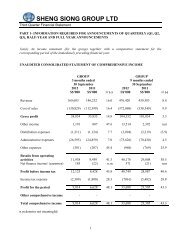FY 2011 Annual Report - Sheng Siong
FY 2011 Annual Report - Sheng Siong
FY 2011 Annual Report - Sheng Siong
Create successful ePaper yourself
Turn your PDF publications into a flip-book with our unique Google optimized e-Paper software.
<strong>Sheng</strong> <strong>Siong</strong> <strong>Annual</strong> <strong>Report</strong> <strong>2011</strong><br />
Notes to the Financial Statements<br />
4 Significant accounting policies (Continued)<br />
4.5 Leases (Continued)<br />
When the Group is a lessee of an operating lease<br />
Where the Group has the use of assets under operating leases, payments made under the leases are recognised<br />
in profit or loss on a straight-line basis over the term of the lease. Lease incentives received are recognised in<br />
profit or loss as an integral part of the total lease payments made.<br />
4.6 Inventories<br />
Inventories are measured at the lower of cost and net realisable value. The cost of inventories is based on the<br />
weighted average cost formula, and includes expenditure incurred in acquiring the inventories, production or<br />
conversion costs and other costs incurred in bringing them to their existing location and condition. In addition,<br />
the Group receives payments from suppliers for various programs, primarily display charges, volume rebates<br />
and reimbursements for costs to promote the suppliers’ products (cooperative advertising arrangements).<br />
Substantially all payments from suppliers are accounted for as a reduction in cost of purchased inventories and<br />
recognised in cost of sales when the related inventories are sold. Net realisable value is the estimated selling<br />
price in the ordinary course of business, less the estimated costs of completion and selling expenses.<br />
4.7 Impairment<br />
Non-derivative financial assets<br />
A financial asset not carried at fair value through profit or loss is assessed at the end of each reporting period<br />
to determine whether there is objective evidence that it is impaired. A financial asset is impaired if objective<br />
evidence indicates that a loss event has occurred after the initial recognition of the asset, and that the loss<br />
event has a negative effect on the estimated future cash flows of that asset that can be estimated reliably.<br />
Objective evidence that financial assets (including equity securities) are impaired can include default or<br />
delinquency by a debtor, restructuring of an amount due to the Group on terms that the Group would not<br />
consider otherwise, indications that a debtor or issuer will enter bankruptcy, and economic conditions that<br />
correlate with defaults or the disappearance of an active market for a security. In addition, for an investment<br />
in an equity security, a significant or prolonged decline in its fair value below its cost is objective evidence of<br />
impairment.<br />
Loans and receivables<br />
The Group considers evidence of impairment for loans and receivables at both a specific asset and collective<br />
level. All individually significant loans and receivables are assessed for specific impairment. All individually<br />
significant receivables found not to be specifically impaired are then collectively assessed for any impairment that<br />
has been incurred but not yet identified. Loans and receivables that are not individually significant are collectively<br />
assessed for impairment by grouping together loans and receivables with similar risk characteristics.<br />
In assessing collective impairment, the Group uses historical trends of the probability of default, the timing<br />
of recoveries and the amount of loss incurred, adjusted for management’s judgement as to whether current<br />
economic and credit conditions are such that the actual losses are likely to be greater or less than suggested<br />
by historical trends.<br />
53



